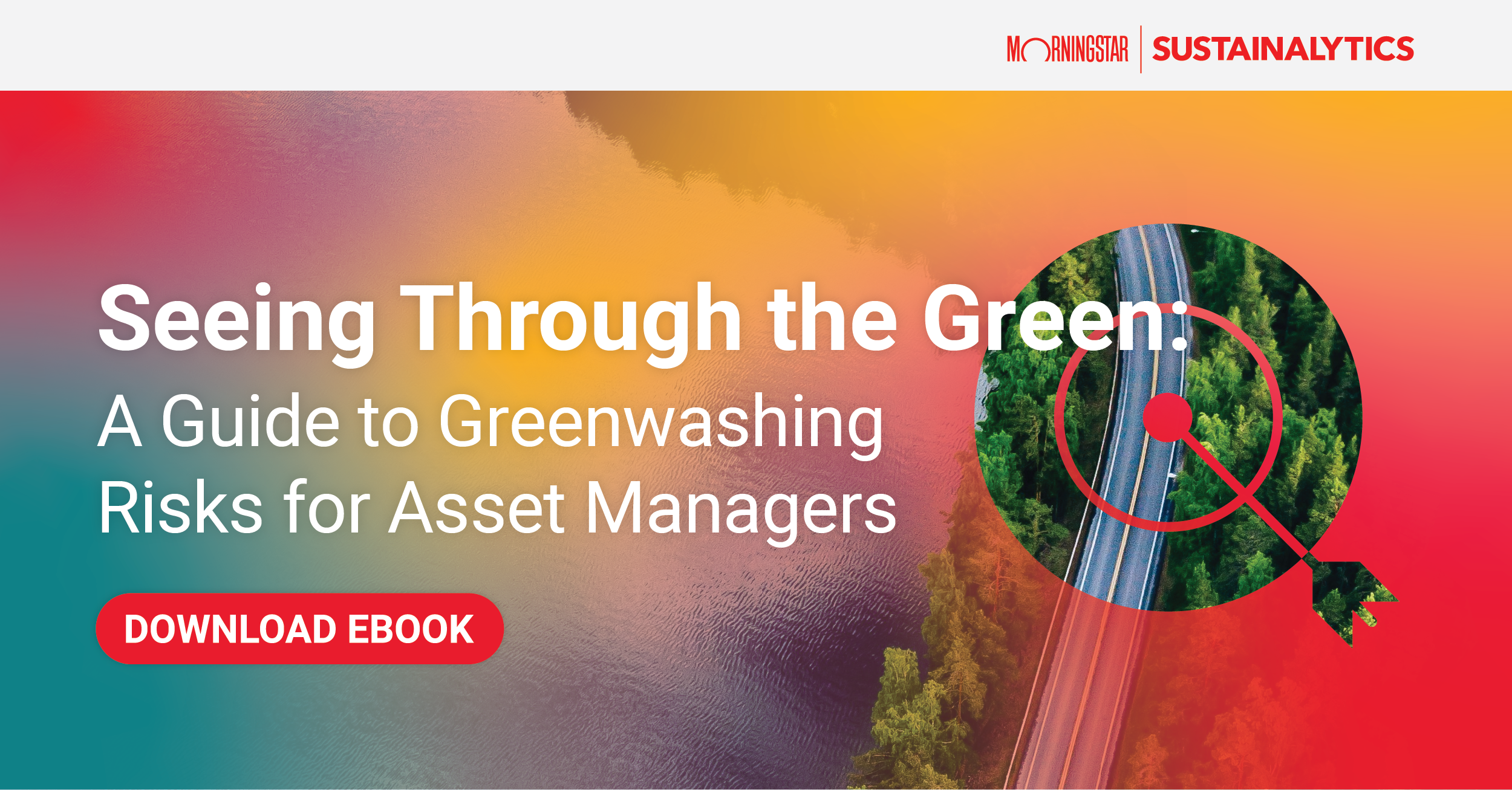In This Article:
| Risks of Greenwashing for Investors |
| Regulations That Address Greenwashing |
| How Investors Can Recognize Greenwashing |
When Deutche Bank’s subsidiary, DWS, agreed to pay a USD19 million fine in September 2023 for greenwashing,1 it sent a message to every asset manager: the risks of making misleading sustainability claims are real and consequential. This evolution in accountability comes at a time when environmental, social, and governance (ESG) issues, particularly climate action and carbon emissions, are under an intense microscope. ESG-labeled products, which have soared in popularity for their promise of a green portfolio, now face the rigorous scrutiny of a broader stakeholder base, including regulators who are no longer content with surface-level assertions.
Still, sustainable products and investing have become big business and asset managers are motivated to offer products with ESG-related goals, such as low-carbon or net zero-aligned portfolios, to meet client demand. According to the Morningstar’s 2023 Voice of the Asset Owner Survey, compared to 2022, the percentage of asset owners with more than half of their total assets reflecting ESG considerations has increased from 30 to 34%.2
As ESG-labeled products have exploded in popularity, significant new challenges and risks have appeared for investors. For instance:
- Investors that fail to do meaningful due diligence or meet compliance requirements may face claims of greenwashing, legal and financial issues, and damage to their brand and client confidence.
- Regulators are increasingly demanding more ESG disclosures and it can be difficult to find and verify the data needed to ensure investments meet ESG criteria and compliance requirements.
- Shareholders, regulators, activists, customers, and the general public, are questioning asset managers over the sustainability claims they make about their investment products like never before.
Integrating sustainability goals into products and product messaging – while addressing greenwashing risks – is complicated. Even the most detail-focused investor with exemplary due diligence may unintentionally mislead clients. Watch the video below or read on to get a deeper understanding of greenwashing, its related definitions, risks, and mitigation tools asset managers need to understand.
The Definition of Greenwashing
In 2023, the European Securities and Markets Authority (ESMA) released what it calls a “high-level consensus definition” that defines greenwashing, intentional or not, as:
“a practice where sustainability-related statements, declarations, actions, or communications do not clearly and fairly reflect the underlying sustainability profile of an entity, a financial product, or financial services. This practice may be misleading to consumers, investors, or other market participants.”3
This is the only standardized definition in use so far, but more will come as regulations advance around the world. It is important to highlight how the ESMA defines greenwashing as misleading sustainability claims, expanding it to more than environmental issues. In addition to the ESMA definition, there are a number of other terms used to describe different forms of greenwashing as highlighted in Table 1.
Table 1. Forms of Greenwashing
Greenwashing Type | Description |
Greenshifting | Transferring blame for sustainability shortfalls to consumers. |
Green-hushing | Keeping quiet about corporate sustainability goals and progress. |
Green-crowding | Modeling sustainability activities after late adopters. |
Greenlighting | Using sustainability initiatives to distract from harmful activities. |
Impact-washing | Overstating a portfolio’s positive impacts. |
Source: Compiled by Morningstar Sustainalytics. For informational purposes only.
Risks of Greenwashing for Investors
Despite having a consensus definition of greenwashing in the EU, there’s still a lack of agreement across different markets. The absence of broadly accepted reporting and auditing rules make it challenging for asset managers to clearly understand their compliance obligations. These factors and others can lead asset managers to inadvertently make exaggerated or otherwise misleading ESG claims.
Broadly speaking, there are three main types of greenwashing risks for asset managers: compliance and regulatory risks, financial risks, and reputational risks.
Compliance and Regulatory Risks
Greenwashing risks related to compliance and regulations include missing reporting deadlines, providing incomplete or inaccurate information to regulators or investors, or failing to define and follow internal policies and practices.
These actions may lead to investigations, penalties from financial authorities, liabilities, and other legal action. If a company provides misleading data, investors may make investment decisions with greater risk that doesn’t match the portfolio’s risk profile.
Financial Risks
What happens when someone claims that a firm is making misleading statements about their sustainable investment products? If authorities find they have greenwashed their products, they may face financial penalties alongside the legal and opportunity costs to defend their firm.
At the same time, if an investee company poorly manages its greenwashing risk and is exposed for making misleading claims, investors may see the value of their investments negatively impacted. The exposed company’s reputation will be damaged and investor confidence may suffer.
Misleading information may also hide additional underlying financial risks associated with unsustainable business practices, such as regulatory fines, reputational damage, or potential litigation. The DWS example mentioned above is just one of many instances where firms have had to pay large fines for misrepresenting their green investing principles.
Reputational Risks
By the time the legal threat is over, firms may have already experienced a crisis of trust and lost market share. Indeed, if a greenwashing claim resonates with certain investors, even the threat of legal action may be enough to damage a firm’s reputation, especially if the claim is difficult to refute and relates to a core aspect of the portfolio.
Regulations That Address Greenwashing
Aside from the financial penalties that authorities may impose on investors if they are found to have made misleading claims or engaged in related practices, regulators are increasingly serious about tackling greenwashing. In particular, authorities around the world are introducing regulations to prevent greenwashing and reduce the risks for investors.
Greenwashing Regulations in Europe
So far, the European Union has the most advanced regulatory environment, with its Action Plan for Sustainable Finance, adopted in 2018. The most important regulations are:
- Sustainable Finance Disclosure Regulation (SFDR): Enacted in 2021, the SFDR aims to align financial flows with sustainable development goals and agreements and empower investors to make informed decisions to reduce the risk of greenwashing.4 Specifically, under the SFDR, asset managers must disclose the processes they use to integrate sustainability, how they consider adverse impacts, and their methods to align investment products with their sustainability objectives, among other requirements.
- EU Taxonomy Regulation: In force since 2021, the Taxonomy Regulation defines what can be considered an environmentally sustainable economic activity within the European Union. To be considered “sustainable” or “taxonomy-aligned,” an activity must satisfy four primary conditions and contribute to at least one of six environmental objectives, with social objectives still to be confirmed and defined.5 The taxonomy addresses greenwashing by providing investors with clear indicators of sustainable activities.
- Corporate Sustainability Reporting Directive (CSRD): The CSRD came into force in 2023 to expand on the requirements of the Non-Financial Reporting Directive (NFRD) and place non-financial reporting on similar footing to traditional financial reporting.6 The CSRD addresses the limitations of the NFRD by standardizing, expanding and strengthening the reporting requirements — and applying them to approximately 50,000 small, medium and large companies that operate in the EU.
Greenwashing Regulations in North America
The U.S. Securities and Exchange Commission has introduced new climate disclosure rules that address greenwashing in investments. The climate disclosure rules require public companies to report on material climate-related risks, transition risks, severe weather events, and greenhouse gas emissions. The rules aim to standardize climate-related disclosures and will provide verifiable and comparable data to investors to support investment decision making.
In Canada, the Canadian Securities Administrators has proposed disclosure requirements to address greenwashing and in 2024 produced updated guidance for issuers on ESG disclosures.7
Greenwashing Regulations in the Asia-Pacific Region
Many of the largest countries and economies in Asia have developed sustainable finance taxonomies or have proposed rules and regulations aimed at addressing greenwashing. Over the next few years, expect to see important developments in Singapore, Malaysia, Japan, Hong Kong, China, and India, among others.
How Investors Can Recognize Greenwashing
There are countless signs of greenwashing or related deceptive practices that investors can look out for. One of the most prevalent ways companies inflate their sustainability progress and credentials is by setting long-term, highly ambitious carbon reduction targets, but then fail to take action or make the changes needed to meet those commitments.
According to data from Morningstar Sustainalytics’ Low Carbon Transition Ratings, 91% of companies are not on track to meet their stated greenhouse gas reduction targets. While ambitious carbon reduction targets are not a red flag in themselves, investors cannot take such claims at face value. They must look into the strategy and actions a company is applying to meet those targets.
Greenwashing Red Flags to Look Out For
Other important indicators of greenwashing include:
- Lack of transparency: Failing to provide transparent information about the company's environmental practices, making it difficult for investors to assess the validity of environmental claims.
- Vague or exaggerated claims: Using terms like "eco-friendly," "green," or "sustainable," or overstating the environmental benefits of products or practices without providing evidence for these claims.
- Diversions: Shifting attention away from sustainability issues by focusing on unrelated charitable activities or highlighting minor improvements, while neglecting impacts elsewhere in the company's operations, for example scope 3 emissions.
- Misleading branding: Using nature-related imagery or symbols to create the impression of sustainability, even if the company's practices do not align with these visuals.
- False certifications: Displaying misleading certifications or labels that imply third-party endorsement of environmental claims without actually meeting rigorous environmental standards.
Essential Tools to Expose Greenwashing
Stewardship and engagement, credible data, and ESG ratings are all reliable tools to enhance due diligence processes, verify sustainability claims, make more informed investment decisions, and reduce the risk of falling victim to greenwashing or misleading ESG claims.
One of the most valuable tools asset managers can use to shine a light on greenwashing is stewardship. This involves directly engaging companies to assess their commitment to sustainability and encourage transparency around their sustainability goals and performance.
Equally important as stewardship is robust, verified data. These days, investors are most interested in investees’ carbon emissions, energy usage, resource management, and overall impact on climate change. Reliable climate data enables investors to differentiate between genuine efforts to mitigate environmental impact and mere greenwashing. By incorporating trustworthy climate data into their investment analysis, asset managers can get a better view of the risks and make more informed decisions and avoid investments based on misleading or insufficient environmental claims.
ESG ratings can also be a powerful tool to shine a light on greenwashing risks. With the Sustainalytics ESG Risk Rating, for example, investors can credibly assess and compare companies’ ESG performance across numerous dimensions.
The Final Word on Greenwashing
The landscape of sustainable investing is both burgeoning and fraught with the perils of greenwashing. Recent high-profile legal cases and large fines are a stark reminder that the ramifications for misleading investors are significant and tangible. As ESG considerations become more integral to investment strategies, the industry faces a pivotal moment. Transparency, integrity, and due diligence are not merely regulatory requirements but foundational to investor trust and the long-term viability of ESG initiatives. Investors and asset managers alike must adopt a vigilant stance, armed with the tools and knowledge to discern between true sustainability and superficial claims.
As regulatory bodies around the world sharpen their focus on combating greenwashing, the financial sector must also elevate its standards. By embracing stringent disclosures, committing to clear and achievable targets, and fostering a culture of accountability, asset managers can mitigate the risks associated with greenwashing.
Ultimately, the fight against greenwashing is not only about protecting investors but also about the collective responsibility of shaping a sustainable future.
Learn more about the best practices to mitigate greenwashing risks in our recent guide, Seeing Through the Green: A Guide to Greenwashing Risks for Asset Managers.
References
- Segal, M. SEC Fines Deutsche Bank Subsidiary $19 Million Following Greenwashing Investigation. September 26, 2023. ESG Today. https://www.esgtoday.com/sec-fines-deutsche-bank-subsidiary-dws-19-million-following-greenwashing-investigation/
- Kuh, T., Gast, A. Voice of the Asset Owner Survey 2023: Quantitative Analysis. October 2023. Morningstar. https://assets.contentstack.io/v3/assets/bltabf2a7413d5a8f05/blt933cb07c08fa9f1d/6553b26c0e64b99bd46ecbaf/Voice-of-the-Asset-Owner-Survey-2023-Quant-Analysis.pdf
- European Securities and Markets Authority. ESAs Put Forward Common Understanding of Greenwashing and Warn on Risks. June 1, 2023. ESMA. https://www.esma.europa.eu/press-news/esma-news/esas-put-forward-common-understanding-greenwashing-and-warn-risks
- European Commission. Sustainability-Related Disclosure in the Financial Services Sector. Accessed: April 15, 2024. https://finance.ec.europa.eu/sustainable-finance/disclosures/sustainability-related-disclosure-financial-services-sector_en
- European Commission. EU Taxonomy Navigator. Accessed: April 15, 2024. https://ec.europa.eu/sustainable-finance-taxonomy/
- European Commission. Corporate Sustainability Reporting. Accessed: April 15, 2024. https://finance.ec.europa.eu/capital-markets-union-and-financial-markets/company-reporting-and-auditing/company-reporting/corporate-sustainability-reporting_en
- Alberta Securities Commission. Canadian Securities Regulators Publish Updated Guidance on ESG-Related Investment Fund Disclosure. March 7, 2024. https://www.asc.ca/en/news-and-publications/news-releases/2024/03/mar-7-canadian-securities-regulators-publish-updated-guidance-on-esg





